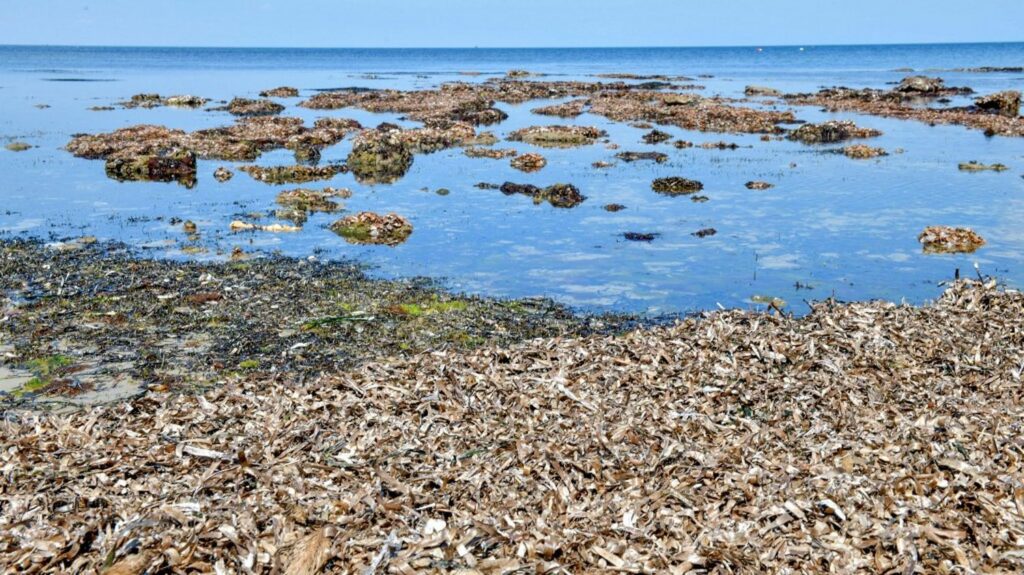In Tunisia, Posidonia, a seagrass on which fishing and tourism depend, a crucial sector for the country’s economy, risks disappearing, threatened by ignorance of its role, illegal fishing and pollution, scientists are alarmed. . « Tunisia has by far the largest seagrass beds in the Mediterranean », more than a million hectares, assures Rym Zakhama-Sraieb, researcher in marine ecology in Tunis. These underwater forests, present up to 50 meters deep, provide shelter for many species of fish. The leaves of « posidonia oceanica » also help to break the waves and thus preserve the coast from erosion.
« The existence of all Tunisian economic activities depends on Posidonia, which is the biggest job provider in the country. »
Yassine Ramzi Sghaier, expert in marine biologyat AFP
The expert cites in particular the fishing (150,000 direct jobs) and tourism (tens of thousands) sectors.
Bundle of leaves, roots and rhizomes, creeping stems generally buried in the ground, Posidonia grows very slowly, less than five centimeters per year. Thanks to the rhizomes, the meadows store carbon and produce oxygen, which is why Posidonia is called « blue carbon »Explain Rym Zakhama-Sraieb, pointing out that it produces 14 to 20 liters of oxygen per square meter. Seagrasses, which absorb three times more carbon than a forest, can fix large amounts over thousands of years, according to the researcher. « In a context of climate change, we need Posidonia to capture as much carbon as possible », abounds Yassine Ramzi Sghaier, expert in marine biology.

For lack of resources, researchers cannot quantify the destruction of meadows in recent years in Tunisia. But they point to multiple reasons in a country where nearly 70% of the inhabitants live on 1,400 km of coastline: human activities, coastal development, illegal fishing, aquaculture farms set up on seagrass beds. Due to the ignorance of the general public and decision makers, « benches » Posidonia washed up on beaches, for example, are often considered waste. Sometimes bulldozers are used to evacuate them, removing a lot of sand and accelerating erosion, according to researchers who say they fear the disappearance of nearly half of Tunisian beaches.
Even stranded on the beach, the « benches » Posidonia protect the coasts from the swell. They also improve the quality of the water and its transparency, making swimming more attractive for tourists, recalls Rym Zakhama-Sraieb. In Tunisia, beaches are one of the great assets of tourism, a sector which represents up to 14% of GDP depending on the year. However, 44% of the country’s beaches are at risk of erosion due to rising sea levels. « We are helping to make beaches disappear by removing the benches »warns Ahmed Ben Hmida, manager of marine and coastal areas with the government agency for the protection and development of the coast (Apal).

Nearly 40% of fishing activity also takes place in seagrass beds, according to scientists. A sector that represents 13% of GDP in Tunisia. A 2010 study noted a massive regression of seagrass beds in the Gulf of Gabès (south-east) due to illegal fishing (trawling on seagrass beds) and pollution. Since the 1970s, chemical phosphate treatment plants have dumped phosphogypsum there. Result: less than 40% of Posidonia meadows remain in this region, regrets Yassine Sghaier.
Even if he fishes further north, in Monastir (center-east), Mazen Magdiche catches three times less fish than 25 years ago. « There are fewer and fewer of them in the shallow waters where the Posidonia is found », says the fisherman. Although aware of the importance of Posidonia, he understands his colleagues, in particular « small fishermen with derisory means »: « You are not looking for the interests of the sea but to feed your children, your family. »
« The sea is destroyed. Chemicals are dumped everywhere. Our sea has changed. »
Mazen Magdiche, fishermanat AFP
Ahmed Ben Hmida of Apal wants « keep hoping to save this treasure », especially through « the forthcoming creation of four marine and coastal protected areas: the islands of Galite (north), Zembra (north-east), Kuriat (north-east) and Kneiss (east) ». But he warns: « If nothing is done to protect all of the posidonia, we are heading towards a real disaster. »

